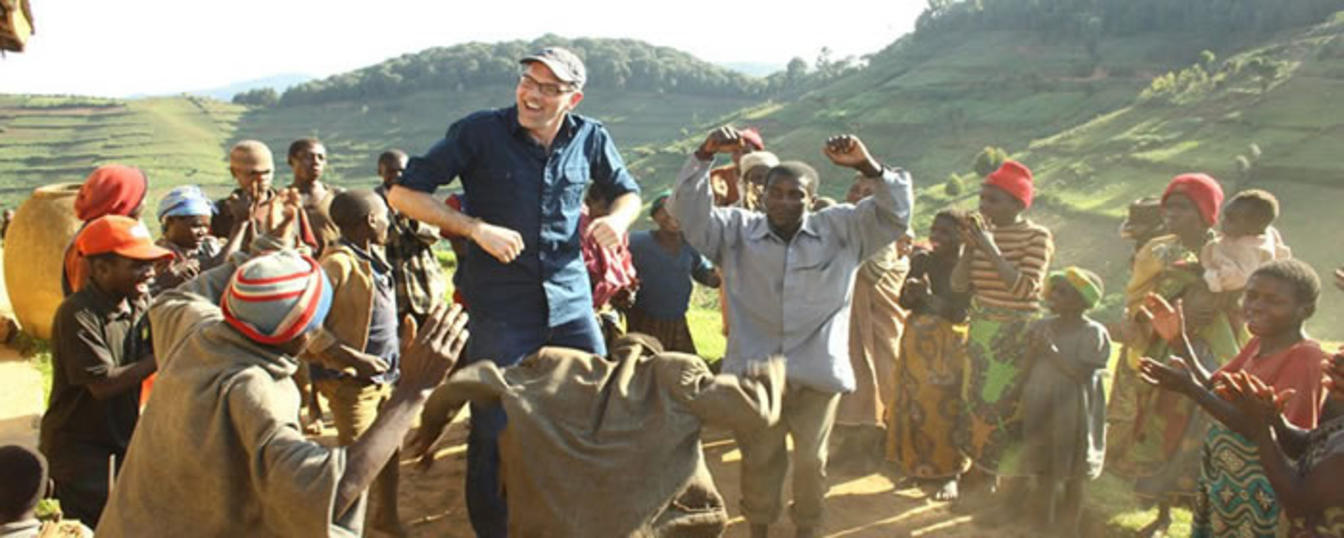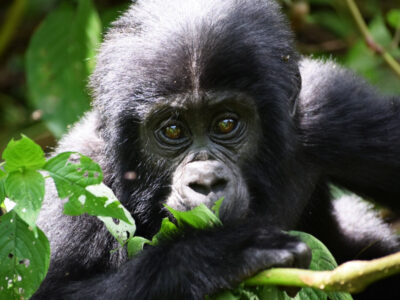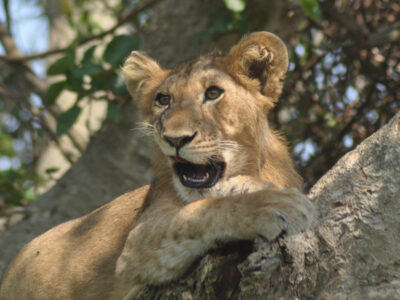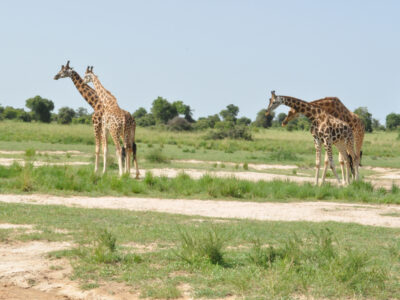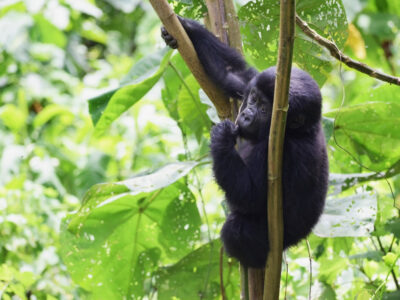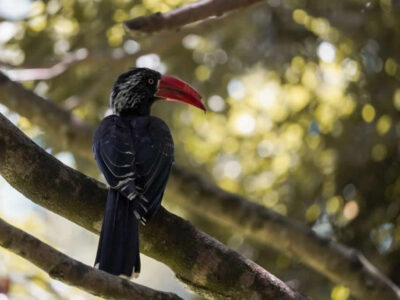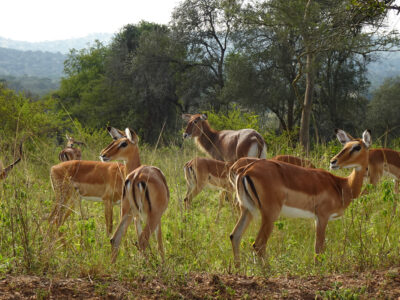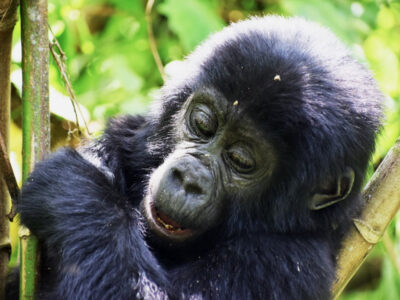The communities that live around gorilla trekking national parks are the Batwa pygmies who reside in most places like Rubuguri and Nteko parishes in the Kisoro district, which borders the southern part of Bwindi impenetrable forest that harbors the endangered mountain gorillas.
Bwindi Impenetrable National Park is located in the south-western corner of Uganda with the highest population of critically endangered mountain gorillas. Over 400 mountain gorillas populate the Bwindi forest, equivalent to over half of the mountain gorillas that live in the wild.
Before Bwindi was deputed as a national park in 1991, it was then a forest reserve, and communities around had full control of the resources that benefited their day-to-day necessities, such as firewood, food, medicinal plants, timber, and game meat. When access to those resources was denied and chased out of the reserve, conflicts broke out between local people and park authorities, which jeopardized the authorities’ ability to manage the park.
Major Batwa evictions took place in Mgahinga National Park and Bwindi Impenetrable Forest in the early 1930s and later in the 1990s. The Batwa people have been peacefully coexisting in the thick forests of these two national parks for countless years. They made a living by hunting and gathering fruit. The Ugandan government viewed the Batwa as poachers and hunters and felt that it was necessary to protect the rare and endangered mountain gorillas that called the forests of Bwindi and Mgahinga home. First, in order to live in certain camps and villages outside the two parks, the Batwa were compelled to renounce their cultural heritage, traditions, and way of life.
Challenges people around gorilla national parks face
The major problem for people around Bwindi impenetrable forest and Mgahinga national park is poverty. The activities that generate income in these areas are minimal and their productivity in terms of crops is not favorable, so generally, they get a low income. Hence, as the human population rises, the potential conflicts over food and space with the wildlife flare.
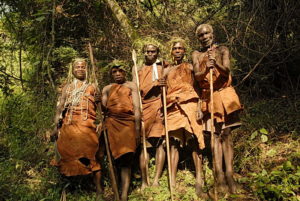
There have been issues with society. They are now required to coexist with nearby native tribes that they had long shunned. Because of their distinctive way of life, the Batwa experience stigma and discrimination from their neighbors who view them as intruders on their property, and have generally disregarded them. Given their relative poverty and general inability to integrate successfully, some of them still fantasize about returning to their former usual environment in the forest. Some of them continue to poach animals like antelopes in the park, while others live as beggars.
Despite great efforts by the government and several international and local organizations to help ensure a smooth transition to their new settlements, things haven’t gone according to plan. The Batwa have never adapted their new way of life and settlements. They have to deal with new diseases which are something they had never experienced considering that the forests provided for their need. While in the forest, they could go hunting, harvest honey, or gather fruits. Now they have to practice beekeeping and other farming methods which they find difficult considering the rudimentary methods still used.
Since they are reserved and protected, there are no longer any free items in the forest. They are required to labor and cultivate their own beans, potatoes, fruit, and vegetables. Some people have resorted to felling trees to make charcoal and fuel. Men and women frequently bring hefty loads of goods to market locations to sell in order to make money to support their necessities.
The Batwa Trail in Mgahinga
Only the Mgahinga Gorilla National Park and Bwindi Impenetrable Forest National Park offer the Batwa Trail and cultural experiences, respectively. One of the most creative projects undertaken by the Batwa-supporting groups aims to use tourism revenue to give Batwa greater social and economic influence. One of the best community excursions in Uganda is provided by the Batwa Trail.
What are the Batwa Trail and cultural experiences?
For tourists and visitors who are interested in learning about the manner of life and history of the Batwa people while they lived in the forest, this experience has been created. Visitors will have a better understanding of why the Batwa have yet to successfully transition to life outside of the forest once the activity is complete.
Only Mgahinga National Park conducts the Batwa Trail. This is distinct from the Batwa cultural tour in Bwindi since it is a lengthier experience that takes place inside the forests of Mgahinga and the activity often begins in the morning. The Batwa groups that reside outside the Bwindi forest typically participate in the cultural experience.
The 5-hour Batwa Trail is typically guided by the Batwa people themselves, and it starts with a kneeling-down prayer to the forest spirits asking them to protect everyone on the trip. The hunting expeditions were fortunate and successful thanks to this custom from long ago. The Batwa guide takes tourists around the Mgahinga Mountains’ slopes and into a deep forest after the spirit prayer.
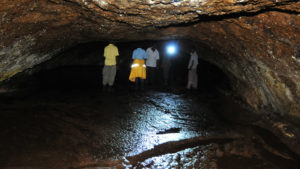
You will learn the value of each plant and weed in the forest throughout your time on the Batwa route. The tour guide will frequently pause to collect leaves from trees and explain their value in medicine. There are leaves that can treat diabetes, high blood pressure, fever, and even the common cold. Typically, these treatments are first chewed or mashed in the mouth. You’ll discover how the Batwa prepare their customary foods, construct their houses, gather honey, and start fires in addition to learning about the forest medicines. The Batwa were talented artisans as well, and some of their creations, like a cup made of bamboo, will impress you. The Batwa will recount tales that highlight their creation, history, and way of living in the forest all along the trail.
You will learn the value of each plant and weed in the forest throughout your time on the Batwa route. The tour guide will frequently pause to collect leaves from trees and explain their value in medicine. There are leaves that can treat diabetes, high blood pressure, fever, and even the common cold. Typically, these treatments are first chewed or mashed in the mouth. You’ll discover how the Batwa prepare their customary foods, construct their houses, gather honey, and start fires in addition to learning about the forest medicines. The Batwa were talented artisans as well, and some of their creations, like a cup made of bamboo, will impress you. The Batwa will recount tales that highlight their creation, history, and way of living in the forest all along the trail.
During your time traveling the Batwa trail, you will learn about the importance of each plant and weed in the forest. The tour guide will frequently take a break to gather tree leaves and describe their usage in medicine. The common cold, high blood pressure, diabetes, and even high blood pressure can all be treated with certain leaves. These medications are typically first chewed or mashed in the mouth. Along with learning about the forest medicines, you’ll find out how the Batwa build their huts, harvest honey, light fires, and prepare their traditional cuisine. You will be impressed by some of Batwa’s products, such as a bamboo cup, as they were skilled artists. The Batwa will share stories about their origin, history, and way of life in
Things to consider before going for the Batwa Cultural trail in Mgahinga
Because the routes are well-maintained and clearly marked, hiking the Batwa trail is comparatively less taxing. There are a few steep parts, especially around the foot of the mountains, but anyone with a reasonable level of fitness should be able to manage this.
To encounter the native tribe that once lived in the park forests for many years and engaged in daily activities like fruit collecting and hunting, you must take the Batwa trek on foot. Since there are no emergency services available in case of a significant incident, those traveling with heavy luggage or equipment might hire a local porter for a reasonable price.
However, tourists wishing to participate in cultural excursions to the Batwa trail in
must pay 80$ since it’s a long day activity that takes about 5 hours to visit different areas including the Garama cave guided by a Mutwa guide, and the Bwindi Impenetrable National Park cultural visit pay a fee of $40 and usually guided by a park guide.
However, the large population of people living around the park makes the development of the area challenging. Reports show that people living around these protected areas are relatively poor and struggling to make a living. While many national parks around the world are safeguarded from people, this means where the park ends, people’s crops start.
That implies that communities living around the park are cramped from the natural resources they are able to harvest in their crops. Supporting their families becomes crucial and they are permitted to be stormed by wild animals like baboons, monkeys, and even mountain gorillas. This makes the promotion of both development and conservation demands.
Benefits of community / cultural visits to the people around the gorilla national parks
The revenue collected from gorilla-tracking activities at both Bwindi Impenetrable and Mgahinga National Parks is critical for reserving the highly-endangered species in the park. However, the local people have a negative attitude towards the park and towards conservation. Though, according to the records, the number of tourists who come to these national parks has increased from about 1300 in 1993 to about 20,000 in 2016.
However, as of recent, a gorilla permit costs $700 to foreign nonresident tourists per person, of which $10 per permit sold goes to communities living around the park, plus 20% of the $40 park entry fees. This is done in recognition of their significance in support of park conservation. This can be traced to tourism initiatives like schools, hospitals, community lodges, craft shops, and others that benefit the local communities through gorillas and other related park activities.
Community tourism is very important to local communities because it gives them another way to earn an extra income that benefits them. When tourists travel to Bwindi, they are motivated to visit various communities after their gorilla trekking, and this requires no bookings. The main community to visit is the Batwa pygmies’ homesteads, one of the aged cultures that are habitually forest hunters and warriors. Apart from gorilla trekking, there are other areas you can visit and explore more, like Buhoma Community Tour, Buniga Forest Walk, Nkuringo Community Tour, Rubuguri Village Walk, and Nkuringo Cultural Center.
The Batwa trail in Mgahinga and the Batwa cultural visit in Bwindi have contributed greatly to the social and economic welfare of the Batwa community by tapping into the generous proceeds from Tourism. By allowing them back in the forest as Tour guides during the Batwa trail in Mgahinga, they feel like the forest still belongs to them. Moreover, money from the tourists/visitors helps supplement their incomes hence improving the incomes of their families.
Among all the safari destinations in Uganda, Bwindi Impenetrable Forest National Park receives the highest number of tourists, and the majority are interested in gorilla trekking. Here, community tourism allows tourists to take part in various activities such as making crafts, tasting their local food, and enjoying traditional dance performances that make them part of the local community.

